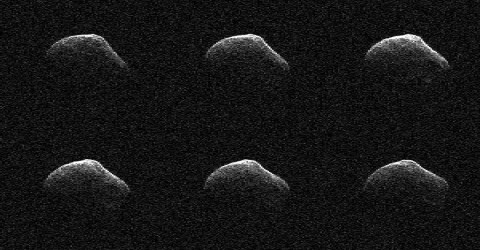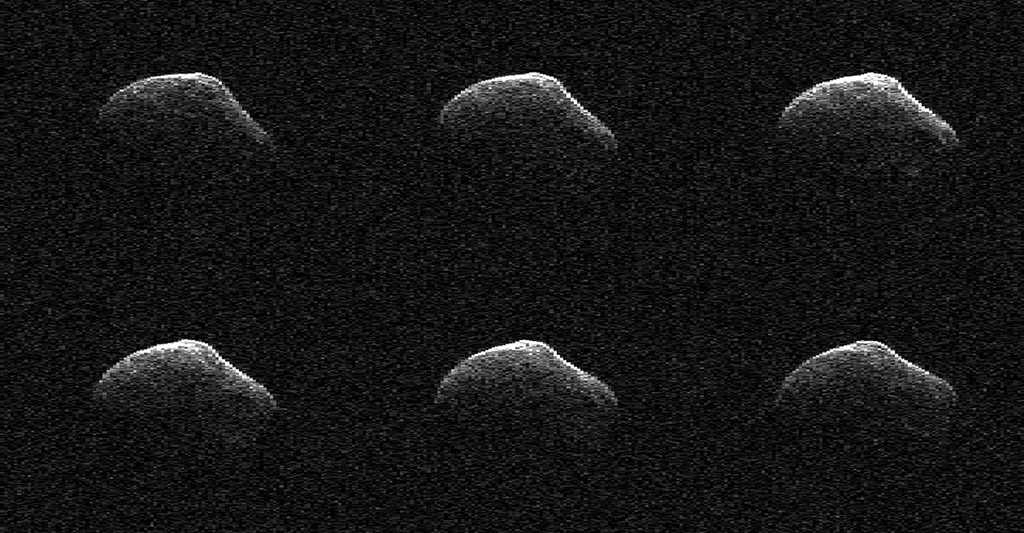Written by DC Agle
NASA’s Jet Propulsion Laboratory
 Pasadena, CA – Astronomers were watching when comet P/2016 BA14 flew past Earth on March 22nd. At the time of its closest approach, the comet was about 2.2 million miles (3.5 million kilometers) away, making it the third closest comet flyby in recorded history (see “A ‘Tail’ of Two Comets”). Radar images from the flyby indicate that the comet is about 3,000 feet (1 kilometer) in diameter.
Pasadena, CA – Astronomers were watching when comet P/2016 BA14 flew past Earth on March 22nd. At the time of its closest approach, the comet was about 2.2 million miles (3.5 million kilometers) away, making it the third closest comet flyby in recorded history (see “A ‘Tail’ of Two Comets”). Radar images from the flyby indicate that the comet is about 3,000 feet (1 kilometer) in diameter.
The scientists used the Goldstone Solar System Radar in California’s Mojave Desert to track the comet.

Astronomers were watching when comet P/2016 BA14 flew past Earth on March 22. At the time of its closest approach, the comet was about 2.2 million miles (3.5 million kilometers) away, making it the third closest comet flyby in recorded history (see “A ‘Tail’ of Two Comets”). Radar images from the flyby indicate that the comet is about 3,000 feet (1 kilometer) in diameter.
The scientists used the Goldstone Solar System Radar in California’s Mojave Desert to track the comet. “We were able to obtain very detailed radar images of the comet nucleus over three nights around the time of closest approach,” said Shantanu Naidu, a postdoctoral researcher at NASA’s Jet Propulsion Laboratory in Pasadena, California, who works with the radar team and led the observations during the comet’s flyby. “We can see surface features as small as 8 meters per pixel.
“The radar images show that the comet has an irregular shape: looks like a brick on one side and a pear on the other,” Naidu said. “We can see quite a few signatures related to topographic features such as large flat regions, small concavities and ridges on the surface of the nucleus.”
Vishnu Reddy, of the Planetary Science Institute, Tucson, Arizona, also observed comet P/2016 BA14 using the NASA Infrared Telescope Facility (IRTF) on Mauna Kea, Hawaii. Data collected (infrared spectra) indicate that the comet reflects less than 3 percent of the sunlight that falls on its surface. Comet nuclei are as dark as fresh asphalt. However, infrared spectra can often yield clues to the makeup of these primitive denizens of the solar system.
More information on the IRTF observations of comet P/2016 BA14 is available at:
http://www.psi.edu/news/darkcomet2
The Center for Near-Earth Object Studies (CNEOS) website has a complete list of recent and upcoming close approaches of comets and asteroids, as well as all other data on the orbits of known near-Earth objects, so scientists, the media and the public can track information on known objects:
For more information about NASA’s Planetary Defense Coordination Office, visit:
http://www.nasa.gov/planetarydefense
For asteroid and comet news and updates, follow AsteroidWatch on Twitter:



